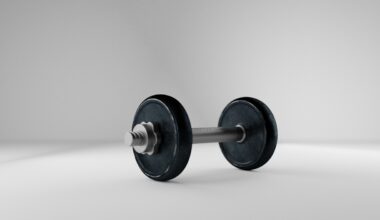Meditation Techniques to Manage Athletic Anxiety
Athletic performance often hinges on mental stability and focus. Athletes frequently experience anxiety, which can disrupt concentration and diminish performance levels. One effective way to manage this anxiety is through various meditation techniques. These practices foster a deeper mind-body connection and help in achieving a calm state of mind. Regular meditation can lower stress levels, improve mental clarity, and enhance overall performance. Importantly, meditation techniques can vary widely, allowing each athlete to find a method that resonates personally. Incorporating breathing exercises, visualization, and specific mindfulness practices into a training routine can lead to significant improvement in handling competitive stress. Athletes who embrace these meditation techniques often report increased emotional resilience as well as greater levels of satisfaction in their sports. Mentally preparing for competition is just as crucial as physical training. By acknowledging the role of anxiety and addressing it through meditation, athletes can transform their experiences. This turning point can lead to improved focus, relaxation, and peak performance in sports. A structured approach to meditation can heighten concentration and emotional control, making it essential for athletes regardless of their sport.
One of the simplest and most beneficial meditation techniques for athletes is mindfulness meditation. This technique involves paying attention to the here and now, focusing on breathing, and observing thoughts without judgment. Athletes can practice mindfulness for just a few minutes at a time, making it accessible during busy training sessions or before competitions. By honing this technique, athletes train their brains to remain focused amidst distractions. Additionally, mindfulness meditation can significantly reduce anxiety by increasing self-awareness and allowing for a better understanding of emotional triggers. When practiced regularly, this technique promotes a calming and nurturing environment within the mind, which is crucial during competitive situations. Athletes can build this practice by setting aside a few moments daily. Utilizing guided meditations or apps can enhance the experience. Notably, it’s important to find a quiet and comfortable space. Eventually, athletes can become adept at calming their minds, effectively preparing for their next challenge. Mindfulness meditation equips athletes with essential tools, fostering not only their athletic performance but also their overall mental health. Thus, prioritizing mindfulness as part of the training regimen is beneficial in the long run.
Visualization Techniques for Competitive Edge
Another foundational meditation method beneficial to athletes is visualization. This technique enables athletes to mentally rehearse their performance, creating a vivid image of success in their minds. Visualization encompasses several aspects of performance, such as movements, techniques, and emotional states. For instance, before a competition, an athlete might visualize executing a perfect routine, tapping into the emotions associated with success. This mental imagery activates neural networks that can enhance actual performance during competition. By engaging all senses during visualization, athletes deepen their mind-body connection, making the outcome feel more achievable. It is often recommended to practice visualization in a quiet space, incorporating elements like breathing exercises beforehand to relax. Consistently practicing these visualization techniques trains the mind to respond positively to anxiety triggers, reducing performance nerves. Incorporating visualization sessions into regular training ensures that athletes are mentally prepared for upcoming events. Additionally, discussing imagery experiences with coaches can provide valuable insights. This transformative technique empowers athletes to trust their capabilities, leading to increased confidence. Through ongoing practice, athletes will find that visualization becomes second nature, allowing them to conquer anxiety and focus on their desired outcomes.
Breath control is a vital component of meditation, especially effective when managing athletic anxiety. Controlled breathing techniques promote relaxation and help calm racing thoughts. One common practice is the 4-7-8 breathing technique, which involves inhaling for four counts, holding the breath for seven counts, and exhaling for eight counts. Implementing this exercise before competitions can facilitate a tranquil state of mind, crucial for peak performance. Athletes can practice this technique during their warm-up routines, enabling them to establish focus before the event starts. Additionally, regular breath control practice enhances lung capacity and energy levels, further benefiting athletic performance. Through this management form, athletes learn to regulate their physiological responses to anxiety. As with other techniques, consistency is key, as the body gradually learns to recognize and respond to these calming signals. By integrating breath control into daily training and meditation routines, athletes can craft a powerful tool for maintaining composure and reducing pre-competition jitters. With time, breath control can significantly enhance mental acuity, allowing athletes to be alert yet relaxed. Ultimately, athletes who master this technique will find it invaluable in competitive environments.
Combining Techniques for Enhanced Meditation
Integrating various meditation techniques can create a more comprehensive strategy for managing athletic anxiety. For example, combining mindfulness with breathing techniques can amplify the calming effects of meditation. When athletes focus on their breath while remaining present, they deepen relaxation and increase concentration. Moreover, the blend of visualization along with breathing exercises can heighten the mental rehearsal experience. As athletes visualize their success, they can simultaneously regulate their breath, enhancing the effectiveness of both techniques. Regularly practicing this combination not only strengthens the athlete’s mental resilience but also fortifies their preparation for challenges beyond just physical exertion. Personalizing a meditation practice by integrating different techniques can foster emotional balance, which is necessary for athletes. Furthermore, sharing and discussing various methods among teammates can create a supportive environment, where all can learn and grow. Exploring these combinations can lead to innovative strategies that enhance individual meditation practices. Continuous experimentation with different techniques can unlock deeper levels of focus and control, ultimately leading to improved performance metrics. Athletes should remain open to adapting to new methods, as individual preferences play a significant role in establishing effective routines.
Finally, consistency is crucial in any meditative practice for managing athletic anxiety. Establishing a regular meditation schedule allows athletes to build a strong foundation for mental resilience. This practice not only leads to immediate benefits but also supports long-term mental health and performance enhancement. Daily meditation sessions, even if brief, can make a profound difference in how athletes cope with pressure. Creating a quiet space dedicated to meditation can further solidify this practice. Athletes should aim for a blend of different techniques, such as mindfulness, breath control, and visualization, to cultivate greater emotional stability. Additionally, seeking guidance from professional trainers or meditation instructors can provide valuable insights. Participating in group meditations or workshops can help maintain motivation and accountability. Sharing experiences within a community can reinforce commitment to these mindfulness practices and reveal new approaches. Long-term benefits of consistent meditation include enhanced focus and decreased anxiety levels. Ultimately, this commitment to a meditation routine can contribute positively to athletes’ overall well-being, leading to successful experiences both in and out of their respective sports. Embracing meditation as an integral part of athletic preparation is essential.
In conclusion, meditation techniques serve as powerful tools for managing athletic anxiety. By adopting practices such as mindfulness, breath control, and visualization, athletes can improve their mental state significantly. Regular meditation sessions foster emotional resilience and create stronger connections between the mind and body. This dual focus on mental well-being and performance leads to improved outcomes both in training and competition. Consistency and dedication to these practices unlock profound benefits for athletes. Additionally, integrating multiple techniques into a personalized routine enhances effectiveness and prepares athletes for the unique pressures of their sports. Seeking guidance from coaches and engaging with peer groups can foster a supportive atmosphere conducive to growth. The structured approach to meditation also cultivates a positive mindset that extends beyond athletic pursuits into daily life. Athletes should embrace the power of these techniques wholeheartedly. By managing anxiety through meditation, athletes can achieve exceptional clarity and focus. Ultimately, meditation empowers athletes, allowing them to face challenges head-on and transform anxiety into a source of inner strength. The journey of integrating meditation into athletic training is transformative, leading to personal breakthroughs and newfound heights in performance.
Creating a Sequential Plan for Meditation
Developing a structured plan for integrating meditation into training can yield effective benefits in managing anxiety. Athletes with a clear framework can systematically engage with different techniques, ensuring each session has a purpose. To start, it’s helpful to set achievable goals for that individual athlete. For instance, allocating three to five minutes of meditation after each warm-up or training session can create a habitual practice. Over time, athletes can gradually increase the duration and complexity of their sessions, incorporating techniques like visualizations or breath control exercises. Athletes might also tweak their practices according to personal preferences or specific competition needs. Keeping a journal helps track progress and allows reflection on which techniques resonate most. This continual adaptation will ensure that the meditation experience remains engaging and rewarding. Importantly, this personalized approach can build confidence and a sense of control over anxiety. Achieving mental clarity and focus through meditation ultimately empowers athletes to perform at their best. As a journey toward mastery, each individual practice nurtures resilience, paving the path for sustained improvement in athletic performance. Therefore, dedicating time to meditation is both valuable and essential.


